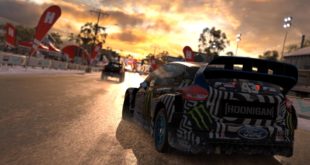Laser League is hard to explain without a host of cultural touchstones to hand. Think Tron, but not really. A MOBA, but not really. It’s perhaps even a little like Rocket League — but not really.
The most important thing to know about Laser League is that it’s good, very good. It’s a futuristic sports game and it has all of the presentation you might expect, with cinematics and lighting routines as teams head to the arena to compete. But that’s where similarities with traditional sports end.
Laser League is a game of class-based warfare, revolving around capturing laser nodes, which, when captured will send out lethal laser beams in several directions, which will then move through the arena in a preset pattern, killing any enemy players that it comes into contact with. This means there’s a scramble for the laser nodes, which return to neutral after a short while, as a desperate battle for survival ensues.
On top of this are six different character classes, each of which have their own unique ability: Thief can ‘steal’ enemy laser walls, hacking them to switch allegiance to his colour, surprising you. Ghost can temporarily become invincible, functioning as a medic as they runs through the map to revive fallen comrades.
I have an affinity for Snipe and Blade, the two most overtly offensive classes. Snipe drops a ball down and can teleport back to it, killing anyone in a line between him and his destination. You can use this to shift quickly through the arena, and even to take out two enemies at once, with skill, positioning, or a bit of luck.
Blade has a sword, and can lunge at you close range to do you in with it. Sure, it’s not teleporting around an arena, but something about the blunt brutality of a character in a future sport just straight up gutting someone with a sword at close range stuck with me.
As I played the characters, I noticed emerging strategies. I was first teamed up with Develop’s Sean Cleaver against a team consisting of a Roll7 staff member and a Eurogamer staffer, and we got completely stuffed. Then, after some coaching from John Ribbins, the game’s director, I started to understand the brilliance behind the game.
Because Laser League isn’t about one of these elements – the lasers, the classes, the blink and you’ll get completely flayed gameplay, but it’s about all of that. Laser League is a lightning-fast competitive sports game that completely won me over within a couple of hours, and I’m eagerly awaiting a chance to play again.
However, I’m more excited to watch professionals get their hands on it. The assorted crowd of Roll7 developers were very vocal with their support when one of us pulled off an impressive kill or danced through an impossible obstacle course of lasers, but we were actually all a bit rubbish. What I’m excited to see is people playing this and tearing it apart to find the best possible options, repurposing the systems to find the most efficient playstyles.
Laser League is compelling to watch, and matches take about the same time as a Rocket League match, with 3 rounds winning a set, and the first team to two sets winning the game.
Ribbins told me that esports isn’t a priority for the team right now, and they are more interested in getting the most polished possible game together for the game’s early access launch, but just as developers can’t decide that they are going to release an esport, they can’t stop an esport from emerging if it’s a success.
In the week since i’ve played Laser League hidden in Shoreditch’s Fnatic Bunker — a fitting place to show off a forthcoming esport — I’ve thought about it daily, remembering the neon soaked arena and tense acts of dodging and weaving through the laser blades cutting across the arena.
It reminded me a little bit of that scene in the original Resident Evil movie — you know the one, with the corridor and the lasers and the gross — and more than anything I’m just hoping to see a tournament organiser step in when the game launches into early access later this year and provides a place for people to throw down in front of an audience.

 MCV/DEVELOP News, events, research and jobs from the games industry
MCV/DEVELOP News, events, research and jobs from the games industry




